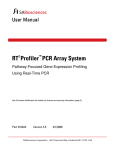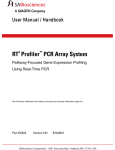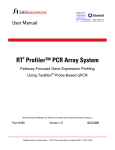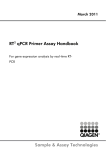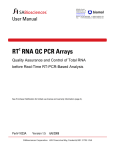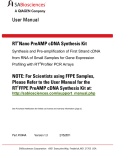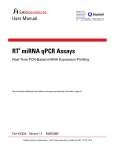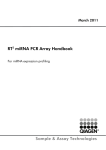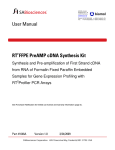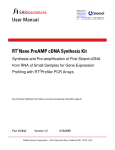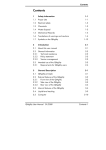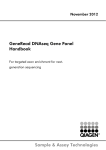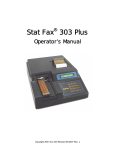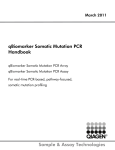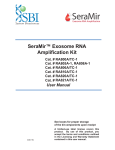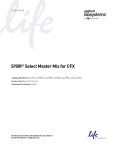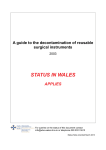Download user manual
Transcript
October 2012 RT2 Predictor PCR Array Handbook RT2 Predictor PCR Array RT2 First Strand Kit RT2 SYBR® Green qPCR Mastermix RT2 SYBR Green Fluor qPCR Mastermix RT2 SYBR Green ROX™ qPCR Mastermix RT2 SYBR Green ROX FAST Mastermix For biological function identification using real-time RT-PCR analysis Sample & Assay Technologies QIAGEN Sample and Assay Technologies QIAGEN is the leading provider of innovative sample and assay technologies, enabling the isolation and detection of contents of any biological sample. Our advanced, high-quality products and services ensure success from sample to result. QIAGEN sets standards in: Purification of DNA, RNA, and proteins Nucleic acid and protein assays microRNA research and RNAi Automation of sample and assay technologies Our mission is to enable you to achieve outstanding success and breakthroughs. For more information, visit www.qiagen.com. Contents Kit Contents 5 Shipping and Storage 9 Product Use Limitations 10 Product Warranty and Satisfaction Guarantee 10 Technical Assistance 10 Safety Information 11 Quality Control 11 Introduction 12 First-strand cDNA synthesis and mastermixes 12 Principle and procedure 13 RNA quality control using an RT2 RNA QC PCR Array 16 Description of protocols 16 Equipment and Reagents to Be Supplied by User 17 Important Notes 18 Preparing a workspace free of DNA contamination 18 RNA preparation, quantification, and quality control 18 Recommended RNA preparation methods 19 RNA quantification and quality control 19 Genomic DNA contamination 21 Starting RNA amounts 22 Protocols cDNA Synthesis Using the RT2 First Strand Kit 23 Real-Time PCR for RT2 Predictor PCR Arrays Formats A, C, D, E, F, G 25 Real-Time PCR for RT2 Predictor PCR Arrays Format R 32 Troubleshooting Guide 36 Appendix A: Data Analysis 38 Derivation of pathway activity probability score based on signature biomarker gene expression between experimental and control samples 38 Classification model and signature biomarker genes derivation from training data set 40 RT2 Predictor PCR Array Handbook 10/2012 3 Principle of ∆∆CT calculation between control and experimental groups for 96-well and 384-well formats 41 Principle of ∆∆CT calculation between control and experimental groups for Rotor-Disc formats 43 Detailed mathematical explanation of ∆∆CT data analysis method 44 References 46 Ordering Information 47 4 RT2 Predictor PCR Array Handbook 10/2012 Kit Contents RT2 Predictor PCR Array Format A* 96-well plate containing dried assays 24 Optical Thin-Wall 8-Cap Strips (12 per 96-well plate) 288 Handbook 1 * Suitable for use with the following real-time cyclers: Applied Biosystems® models 5700, 7000, 7300, 7500, 7700, 7900HT, ViiA™ 7 (96-well block); Bio-Rad® models iCycler®, iQ™5, MyiQ™, MyiQ2; Bio-Rad/MJ Research Chromo4™; Eppendorf® Mastercycler® ep realplex models 2, 2S, 4, 4S; Stratagene® models Mx3005P®, Mx3000P®; Takara TP-800. RT2 Predictor PCR Array Format C† † 96-well plate containing dried assays 24 Optical Adhesive Film (1 per 96-well plate) 24 Handbook 1 Suitable for use with the following real-time cyclers: Applied Biosystems models 7500 (Fast block), 7900HT (Fast block), StepOnePlus™, ViiA 7 (Fast block). RT2 Predictor PCR Array Format D‡ 96-well plate containing dried assays 24 Optical Thin-Wall 8-Cap Strips (12 per 96-well plate) 288 Handbook ‡ 1 Suitable for use with the following real-time cyclers: Bio-Rad CFX96™; Bio-Rad/MJ Research models DNA Engine Opticon®, DNA Engine Opticon 2; Stratagene Mx4000®. RT2 Predictor PCR Array Format E 384 (16 x 24) option*† 384-well plate containing dried assays 8 Optical Adhesive Film (1 per 384-well plate) 8 Handbook 1 * Suitable for use with the following real-time cyclers: Applied Biosystems models 7900HT (384-well block), ViiA 7 (384-well block); Bio-Rad CFX384™. † For a description of the 384 (16 x 24) option, see page 14. RT2 Predictor PCR Array Handbook 10/2012 5 RT2 Predictor PCR Array Format F¶ 96-well plate containing dried assays 24 Optical Adhesive Film (1 per 96-well plate) 24 Handbook 1 Suitable for use with the following real-time cycler: Roche® LightCycler® 480 (96-well block). ¶ RT2 Predictor PCR Array Format G 384 (16 x 24) option *† 384-well plate containing dried assays 8 Optical Adhesive Film (1 per 384-well plate) 8 Handbook 1 * Suitable for use with the following real-time cycler: Roche LightCycler 480 (384-well block). † For a description of the 384 (16 x 24) option, see page 14. RT2 Predictor PCR Array Format R** Rotor-Disc® 100 containing dried assays 24 Rotor-Disc Heat Sealing Film (1 per Rotor-Disc 100) 24 Handbook 1 ** Suitable for use with the following real-time cyclers: QIAGEN® Rotor-Gene® Q; Rotor-Gene 6000; other Rotor-Gene cyclers. RT2 First Strand Kit Catalog no. Number of 20 µl reactions 6 (12) 330401 12 Buffer GE 24 µl 5x Buffer BC3 48 µl RE3 Reverse Transcriptase Mix 24 µl Control P2 12 µl RNase-Free Water 1 ml RT2 Predictor PCR Array Handbook 10/2012 RT2 SYBR Green qPCR Mastermix* (24) (8) (25 ml) Catalog no. 330503 330501 330509 Number of array reactions 24 x 96well 4 x 384well 2000 x 25 µl reactions 2x SYBR Green qPCR Mastermix, containing: 24 x 1.35 ml 8x 1.35 ml 25 ml HotStart DNA Taq Polymerase PCR Buffer dNTP mix (dATP, dCTP, dGTP, dTTP) SYBR Green dye * Suitable for use with real-time cyclers that do not require a reference dye, including: Bio-Rad models CFX96, CFX384; Bio-Rad/MJ Research models Chromo4, DNA Engine Opticon 2; Roche LightCycler 480 (96-well and 384-well). RT2 SYBR Green Fluor qPCR Mastermix* (24) (8) (25 ml) Catalog no. 330513 330511 330519 Number of array reactions 24 x 96well 4 x 384well 2000 x 25 µl reactions 2x SYBR Green Fluor qPCR Mastermix, containing: 24 x 1.35 ml 8x 1.35 ml 25 ml HotStart DNA Taq Polymerase PCR Buffer dNTP mix (dATP, dCTP, dGTP, dTTP) SYBR Green dye Fluorescein passive reference dye * Suitable for use with the following real-time cyclers: Bio-Rad models iCycler, iQ5, MyiQ, MyiQ2. RT2 Predictor PCR Array Handbook 10/2012 7 RT2 SYBR Green ROX qPCR Mastermix* (24) (8) (25 ml) Catalog no. 330523 330521 330529 Number of array reactions 24 x 96well 4 x 384well 2000 x 25 µl reactions 2x SYBR Green ROX qPCR Mastermix, containing: 24 x 1.35 ml 8x 1.35 ml 25 ml HotStart DNA Taq Polymerase PCR Buffer dNTP mix (dATP, dCTP, dGTP, dTTP) SYBR Green dye ROX passive reference dye * Suitable for use with the following real-time cyclers: Applied Biosystems models 5700, 7000, 7300, 7500 (Standard and Fast), 7700, 7900HT (Standard and Fast 96-well block, 384-well block), StepOnePlus, ViiA 7 (Standard and Fast 96-well block, 384-well block); Eppendorf Mastercycler ep realplex models 2, 2S, 4, 4S; Stratagene models Mx3000P, Mx3005P, Mx4000; Takara TP-800. 8 RT2 Predictor PCR Array Handbook 10/2012 RT2 SYBR Green ROX FAST Mastermix* (24) (8) (25 ml) Catalog no. 330623 330621 330629 Number of array reactions 24 x 96well 4 x 384-well 2000 x 25 µl reactions 2x SYBR Green ROX FAST Mastermix, containing: 24 x 1.35 ml 8x 1.35 ml 25 ml HotStart DNA Taq Polymerase PCR Buffer dNTP mix (dATP, dCTP, dGTP, dTTP) SYBR Green dye ROX passive reference dye * Suitable for use with the Rotor-Gene Q (QIAGEN) and Rotor-Gene 6000. Note: RT2 Predictor PCR Arrays cannot be used in the Cepheid SmartCycler® or the Roche LightCycler 2.0. Shipping and Storage RT2 Predictor PCR Array Formats A, C, D, E, F, G, and R are shipped at room temperature (15–25°C) or on ice or dry ice, depending on the destination and accompanying products. All RT2 Predictor PCR Array Formats should be stored at –20°C upon arrival. When stored properly at –20°C, RT2 Predictor PCR Arrays are stable for up to 6 months after delivery. RT² SYBR Green Mastermixes are shipped on cold packs. For long-term storage, keep tubes at –20°C. If the entire volume will not be used at once, we recommend dividing into aliquots and storing at –20°C. Avoid repeated freezing and thawing. If stored under these conditions, RT² SYBR Green Mastermixes are stable for 6 months after receipt. The RT² First Strand Kit is shipped frozen. For long-term storage, keep the kit at –20°C. If stored under these conditions, the RT² First Strand Kit is stable for 6 months after receipt. We recommend a maximum of 6 freeze-thaw cycles. RT2 Predictor PCR Array Handbook 10/2012 9 Product Use Limitations RT2 Predictor PCR Arrays, the RT2 First Strand Kit, and RT2 SYBR Green Mastermixes are intended for molecular biology applications. These products are not intended for the diagnosis, prevention, or treatment of a disease. All due care and attention should be exercised in the handling of the products. We recommend all users of QIAGEN products to adhere to the NIH guidelines that have been developed for recombinant DNA experiments, or to other applicable guidelines. Product Warranty and Satisfaction Guarantee QIAGEN guarantees the performance of all products in the manner described in our product literature. The purchaser must determine the suitability of the product for its particular use. Should any product fail to perform satisfactorily due to any reason other than misuse, QIAGEN will replace it free of charge or refund the purchase price. We reserve the right to change, alter, or modify any product to enhance its performance and design. If a QIAGEN product does not meet your expectations, simply call your local Technical Service Department or distributor. We will credit your account or exchange the product — as you wish. Separate conditions apply to QIAGEN scientific instruments, service products, and to products shipped on dry ice. Please inquire for more information. A copy of QIAGEN terms and conditions can be obtained on request, and is also provided on the back of our invoices. If you have questions about product specifications or performance, please call QIAGEN Technical Services or your local distributor (see back cover or visit www.qiagen.com). Technical Assistance At QIAGEN, we pride ourselves on the quality and availability of our technical support. Our Technical Service Departments are staffed by experienced scientists with extensive practical and theoretical expertise in sample and assay technologies and the use of QIAGEN products. If you have any questions or experience any difficulties regarding RT2 Predictor PCR Arrays, the RT2 First Strand Kit, RT2 SYBR Green Mastermixes, or QIAGEN products in general, please do not hesitate to contact us. QIAGEN customers are a major source of information regarding advanced or specialized uses of our products. This information is helpful to other scientists as well as to the researchers at QIAGEN. We therefore encourage you to contact us if you have any suggestions about product performance or new applications and techniques. For technical assistance and more information, please see our Technical Support Center at www.qiagen.com/Support or call one of the QIAGEN 10 RT2 Predictor PCR Array Handbook 10/2012 Technical Service Departments or local distributors (see back cover or visit www.qiagen.com). Safety Information When working with chemicals, always wear a suitable lab coat, disposable gloves, and protective goggles. For more information, please consult the appropriate safety data sheets (SDSs). These are available online in convenient and compact PDF format at www.qiagen.com/safety where you can find, view, and print the SDS for each QIAGEN kit and kit component. 24-hour emergency information Emergency medical information in English, French, and German can be obtained 24 hours a day from: Poison Information Center Mainz, Germany Tel: +49-6131-19240 Quality Control In accordance with QIAGEN’s Quality Management System, each lot of RT2 Predictor PCR Arrays, RT2 First Strand Kits, and RT2 SYBR Green Mastermixes is tested against predetermined specifications to ensure consistent product quality. RT2 Predictor PCR Array Handbook 10/2012 11 Introduction Real-time RT-PCR is a highly sensitive and reliable method for gene expression analysis. Its wide dynamic range makes real-time RT-PCR the preferred choice for the simultaneous quantification of multiple genes in the same sample. RT2 Predictor PCR Arrays are designed to analyze a panel of genes related to a biological pathway to determine intracellular status of biological function such as signaling and toxic pathway activity. The array, along with classification algorithm, indicates whether the pathway is activated, repressed or whether activity remains unchanged in an experimental sample as compared to a control sample. For each pathway, regulation of pathway activity is determined from the expression levels of its signature biomarker genes, defined as a set of experimentally derived genes in the array whose combined relative expression delivers optimal prediction power for signaling or toxic pathway activity. Multiple sets of signature genes in an RT2 Predictor PCR Array plate allow for testing pathway activity regulation from multiple samples on a single plate for faster throughput. RT2 Predictor PCR Arrays, RT2 SYBR Green Mastermixes, and the RT2 First Strand Kit have been optimized in combination for SYBR Greenbased real-time RT-PCR detection, providing the RT2 Predictor PCR Arrays with superior sensitivity and reliable measurement of biological function. The simplicity of the RT2 Predictor PCR Arrays makes them accessible for routine use in every research laboratory. First-strand cDNA synthesis and mastermixes Performance of RT² Predictor PCR Arrays is only guaranteed when used with RT² SYBR Green Mastermixes and the RT2 First Strand Kit. The combination of RT² Predictor PCR Arrays with RT² SYBR Green Mastermixes and the RT2 First Strand Kit ensures that the PCR assay performance of each signature gene is comparable to what was used to derive the algorithm for biological function prediction. Therefore, the use of the complete RT² Predictor PCR Array System is absolutely essential for obtaining accurate measurement of biological function. The chemically modified and tightly controlled HotStart DNA Taq Polymerase enzyme and other proprietary chemical components in RT2 SYBR Green Mastermixes uniquely provide more accurate SYBR Green results by preventing the amplification of primer-dimers and other nonspecific products. They also help ensure high amplification efficiencies, even for genes that are difficult to amplify. Real-time cyclers use different reference dyes to normalize their optics; therefore, be sure to use the correct mastermix for the real-time cycler in your laboratory. The RT2 First Strand Kit includes a proprietary buffer to eliminate any residual genomic DNA contamination in RNA samples before it can be amplified into secondary products that would otherwise cause false positive signals. The reverse-transcription controls (RTC) on the RT² Predictor PCR Array can only be 12 RT2 Predictor PCR Array Handbook 10/2012 evaluated with the built-in external RNA control of the RT2 First Strand Kit. These controls do not yield results when used with other sources of reverse transcriptase or first strand synthesis kits. The buffer components and the magnesium concentration in the RT2 First Strand Kit are also more compatible with RT² SYBR Green Mastermixes than other enzymes or kits, providing the RT² Predictor PCR Arrays with maximum levels of sensitivity with nanogram to microgram amounts of total RNA. Principle and procedure RT2 Predictor PCR Arrays are provided in 96-well plates, 384-well plates, or Rotor-Discs (Figures 1–3). RT2 Predictor PCR Arrays in 96-well plates contain primer assays for 4 sets of genes and each set contains 16 pathway-specific signature genes, 5 housekeeping genes, one genomic DNA control, one reverse-transcription controls, and one positive PCR controls (Figure 1). RT2 Predictor PCR Arrays in 384-well plates contain 16 replicate primer assays for each set of genes, comprising 16 pathway-specific signature genes, 5 housekeeping genes, one genomic DNA control, one reverse-transcription control, and one positive PCR control (Figure 2). RT2 Predictor PCR Arrays in Rotor-Disc 100 format contain primer assays for 4 sets of genes. Each set contains 16 pathway-specific signature genes, 5 housekeeping genes, one genomic DNA control, one reverse-transcription control, and one positive PCR control. Wells 97–100 of the Rotor-Disc 100 do not contain assays (Figure 3). During the procedure, master mix is added to these wells for balance, but the wells are not used for analysis. Definitions of controls in RT2 Predictor PCR Arrays Assays for 5 housekeeping genes included in the arrays enable normalization of data. The genomic DNA control (GDC) is an assay that specifically detects nontranscribed genomic DNA contamination with a high level of sensitivity. The reverse-transcription control (RTC) is an assay that tests the efficiency of the reverse-transcription reaction performed with the RT2 First Strand Kit by detecting template synthesized from the kit’s built-in external RNA control. The positive PCR control (PPC) consists of a predispensed artificial DNA sequence and the assay that detects it. This control tests the efficiency of the polymerase chain reaction itself. Controls can be used to test for inter-sample, intra-plate consistency. RT2 Predictor PCR Array Handbook 10/2012 13 Figure 1. RT2 Predictor PCR Array Formats A, C, D, F (4 x 24) layout. RT2 Predictor PCR Array Formats A, C, D, and F: Each plate contains 4 sets of real-time PCR assays for pathway activity assessment. Each set of genes contains 16 pathway-specific signature genes (1–16), 5 housekeeping genes (HK1–5) to normalize data, one genomic DNA control (GDC), one reverse-transcription control (RTC), and one positive PCR control (PPC). Figure 2. RT2 Predictor PCR Array Formats E and G 384 (16 x 24) option layout. RT2 Predictor PCR Arrays with the 384 (16 x 24) option include 16 replicates of the same 24 assays that are provided in 4 replicates in the 96-well format shown in Figure 1. 14 RT2 Predictor PCR Array Handbook 10/2012 Figure 3. RT2 Predictor PCR Array Format R layout. RT2 Predictor PCR Array Format R contains the same 4 replicates of 24 assays (wells 1–24, 25–48, 49–72 and 73–96) as in the 96-well format shown in Figure 1. Each set of genes contains 16 pathway-specific signature genes, 5 housekeeping genes (HK) to normalize data, one genomic DNA control (GDC), one reverse-transcription control (RTC) and one positive PCR control (PPC). Wells 97 to 100 are empty. Workflow The procedure begins with the conversion of experimental RNA samples into first-strand cDNA using the RT2 First Strand Kit. Next, the cDNA is mixed with an appropriate RT2 SYBR Green Mastermix. This mixture is aliquoted into the wells corresponding to each sample on the RT2 Predictor PCR Array. PCR is performed and finally pathway activity regulation is determined using data from the real-time cycler and the classification methods derived from our training data with experimentally verified pathway manipulation. RT2 Predictor PCR Array Handbook 10/2012 15 Figure 4. RT2 Predictor PCR Array procedure. RNA quality control using an RT2 RNA QC PCR Array The RT2 RNA QC PCR Array is designed to assess the quality of 12 RNA samples simultaneously before gene expression analysis using RT2 Predictor PCR Arrays. Use of the RT2 RNA QC PCR Array provides complete confidence in gene expression analysis results by enabling exclusion of substandard samples prior to analysis with RT2 Predictor PCR Arrays. For further details, consult the RT2 RNA QC PCR Array Handbook. Description of protocols This handbook contains 4 protocols. The first protocol details cDNA synthesis by reverse transcription using purified RNA and the RT2 First Strand Kit (page 23). This protocol should be performed prior to real-time PCR. The 3 additional protocols detail real-time PCR performed using the cDNA prepared in the first protocol as the template. The protocol on page 25 should be used for 96-well and 384-well RT2 Predictor PCR Arrays Formats A, C, D, E, F, and G. The protocol on page 32 should be used for Rotor-Disc 100 RT2 Predictor PCR Array Format R. 16 RT2 Predictor PCR Array Handbook 10/2012 Equipment and Reagents to Be Supplied by User When working with chemicals, always wear a suitable lab coat, disposable gloves, and protective goggles. For more information, consult the appropriate material safety data sheets (MSDSs), available from the product supplier. In addition to the RT2 Predictor PCR Array, RT2 First Strand Kit, and RT2 SYBR Green Mastermix, the following are required: Purified RNA samples Real-time PCR cycler High-quality, nuclease-free water. Do not use DEPC-treated water. Multichannel pipettor Single-channel pipettor Nuclease-free pipet tips and tubes Optional: XpressRef Universal Total RNA to control PCR conditions is available for human (cat. no. 338112) RT2 Predictor PCR Array Handbook 10/2012 17 Important Notes Preparing a workspace free of DNA contamination For accurate and reproducible RT2 Predictor PCR Array results, it is important to avoid contamination of the assay with foreign DNA. Any DNA contamination will artificially inflate the SYBR Green signal, yielding skewed gene expression profiles and false-positive signals that affect accurate determination of pathway activity regulation. The most common sources of DNA contamination are the products of previous experiments spread into the air of the working environment. To set up and maintain a working environment free of DNA contamination, follow the guidelines below. Wear gloves throughout the procedure. Use only fresh PCR-grade reagents (water) and labware (tips and tubes). Physically separate the workspaces used for PCR setup and post-PCR processing or non-PCR operations. Decontaminate the PCR workspace and labware (pipettor barrels, tube racks, etc.) before each use with UV light (to render any contaminating DNA ineffective in PCR through the formation of thymidine dimers) or with 10% bleach (to chemically inactivate and degrade any DNA). Close all tubes containing PCR products once you are finished adding or removing volumes. Before discarding any labware (tips or tubes) containing PCR products or other DNA, treat with 10% bleach. Do not remove the RT2 Predictor PCR Array from its protective, sealed bag until immediately before use. Do not leave labware (tubes and tip boxes) exposed to the air for long periods of time. Do not open any previously run and stored RT2 Predictor PCR Array. Removing the thin-wall, 8-cap strips or the adhesive film from PCR arrays releases PCR product DNA into the air where it may affect the results of future real-time PCR experiments. RNA preparation, quantification, and quality control High-quality RNA is essential for obtaining good, real-time PCR results. The most important prerequisite for any gene expression analysis experiment is consistently high-quality RNA from every experimental sample. Residual traces of proteins, salts, or other contaminants may degrade the RNA or decrease the efficiency of enzyme activities necessary for optimal reverse transcription and real-time PCR performance. 18 RT2 Predictor PCR Array Handbook 10/2012 Recommended RNA preparation methods High-quality total RNA for your real-time PCR experiment should be prepared using one of the methods described below, depending on the biological sample. For optimal results, RNA samples should be suspended in RNase-free water. Do not use DEPC-treated water. Cultured cells We recommend the RNeasy® Mini Kit (cat. no. 74104) for RNA purification from cultured cells. It is important to perform the on-column DNase digestion step described in the RNeasy Mini Handbook (using the RNase-Free DNase Set [cat. no. 79254]). Tissue samples We recommend the RNeasy Microarray Tissue Mini Kit (cat. no. 73304) including the optional on-column DNase digestion step described in the RNeasy Microarray Tissue Handbook (using the RNase-Free DNase Set [cat. no. 79254]). Whole blood samples We recommend the PAXgene® Blood RNA Kit (cat. no. 762174) for preparation of total RNA from whole blood samples. Alternatively, the QIAamp® RNA Blood Mini Kit (cat. no. 52304) can also be used for this purpose. Total RNA isolated using a phenol-based method Total RNA from any biological source material prepared using a phenol-based method (e.g., QIAzol® Lysis Reagent, TRIzol® Reagent, RNAzol® Reagent) should be further purified using the RNeasy Mini Kit. It is important to perform the oncolumn DNase digestion step described in the RNeasy Mini Handbook. Other biological samples Refer to the existing literature to find protocols for high-quality RNA purification from other biological samples or contact QIAGEN Technical Service. RNA quantification and quality control For best results from the RT2 Predictor PCR Array, all RNA samples should also demonstrate consistent quality according to the criteria described below. In addition, as some contaminants are difficult to detect by simply looking at RNA integrity and can be missed by UV spectrophotometry, it is essential to choose RT2 Predictor PCR Array Handbook 10/2012 19 an appropriate RNA purification method for your biological sample as described on page 19–23. Concentration and purity determined by UV spectrophotometry The concentration and purity of RNA should be determined by measuring the absorbance in a spectrophotometer. Prepare dilutions and measure absorbance in 10 mM Tris·Cl,* pH 8.0. The spectral properties of nucleic acids are highly dependent on pH. An absorbance reading of 1.0 at 260 nm in a 1 cm detection path corresponds to an RNA concentration of 40 µg/ml. A260:A230 ratio should be greater than 1.7 A260:A280 ratio should be 1.8 to 2.0 Concentration determined by A260 should be >40 µg/ml Ribosomal RNA band integrity Run an aliquot of each RNA sample on a denaturing agarose gel or the Agilent® Bioanalyzer using an RNA 6000 Nano LabChip®. Verify that there are sharp bands/peaks present for both the 18S and 28S ribosomal RNAs (Figure 5). Any smearing of the RNA bands or shoulders on the RNA peaks indicates that degradation has occurred in the RNA sample. For reliable data from RT2 Predictor PCR Arrays, an RNA Integrity Number (RIN) of 7 or higher is recommended. Consistent RIN values across multiple samples within each experiment are desirable for reliable quality data comparisons. * When working with chemicals, always wear a suitable lab coat, disposable gloves, and protective goggles. For more information, please consult the appropriate material safety data sheets (MSDSs), available from the product supplier. 20 RT2 Predictor PCR Array Handbook 10/2012 _A_ _B_ Figure 5. Ribosomal RNA integrity. _A_ Agilent Bioanalyzer electropherogram of highquality total RNA showing sharp peaks for the 18S (left) and 28S (right) ribosomal RNA. Due to high quality of the RNA, peaks do not have shoulders (especially to the left of each peak). _B_ Agarose gel electrophoresis shows sharp bands (especially at the bottom of each band) for 28S and 18S ribosomal RNA. RT2 RNA QC PCR Array (optional) The RT2 RNA QC PCR Array is particularly useful for researchers who are unsure of their RNA purification technique. The RT2 RNA QC PCR Array and the RT2 First Strand Kit (sold separately) test for a number of RNA quality control parameters including: High and low housekeeping gene expression levels Reverse transcription and polymerase chain reaction efficiency Genomic and general DNA contamination For further details, consult the RT2 RNA QC PCR Array Handbook. Genomic DNA contamination Eliminating genomic DNA contamination is essential for obtaining optimal analysis of pathway regulation using the RT2 Predictor PCR Array. The genomic DNA control in each RT2 Predictor PCR Array specifically tests for genomic DNA contamination in each sample during each run. A genomic DNA control threshold cycle value of less than 35 indicates the presence of a detectable amount of genomic DNA contamination that should be addressed. To remove any residual contamination from your RNA samples, we strongly recommend RNA purification using the RNeasy Mini Kit including the optional on-column DNase digestion step, followed by cDNA synthesis using the RT2 First Strand Kit. If required, individual, species-specific RT2 qPCR Primer gDNA Controls are available. RT2 Predictor PCR Array Handbook 10/2012 21 Starting RNA amounts The RT2 Predictor PCR Array System provides results with as little as 100 ng or as much as 1 µg total RNA per sample. The optimal amount of starting material depends on the relative abundance of the transcripts of interest. Lower abundance transcripts require more RNA; higher abundance transcripts require less RNA. Greater amounts of input total RNA yield a greater number of positive calls (i.e., genes expressed in the linear dynamic range of the method). Lower amounts of input total RNA yield a smaller number of positive calls and an increase in false negative calls. For successful results and maximum positive call rates that are important for determination of pathway activity regulation, we recommend that first-time users start with 300 ng total RNA for each sample. It is important to use a consistent amount of total RNA for all samples in a single experiment. 22 RT2 Predictor PCR Array Handbook 10/2012 Protocol: cDNA Synthesis Using the RT2 First Strand Kit Use of the RT2 First Strand Kit is critical for obtaining optimal results and for detection of the reverse transcription controls contained in the RT2 Predictor PCR Array. Important points before starting Use the same amount of total RNA for reverse transcription of each sample. First-time users are recommended to start with 300 ng total RNA for each sample. Use of less than 100 ng RNA will result in a high rate of false negatives that will affect the pathway activity regulation readout. Do not use DEPC-treated water. Use high-quality, nuclease-free water. The RT2 First Stand Kit is not compatible with the chemicals in DNA-free™ kits from Ambion. If your RNA sample has been treated with DNA-free reagents, contact QIAGEN Technical Service. Procedure 1. Thaw the reagents of the RT2 First Strand Kit. Briefly centrifuge (10– 15 s) to bring the contents to the bottom of the tubes. 2. Prepare the genomic DNA elimination mix for each RNA sample according to Table 1. Mix gently by pipetting up and down and then centrifuge briefly. Table 1. Genomic DNA elimination mix Component RNA* Buffer GE RNase-free water Total volume Amount 100 ng–1 µg 2 µl Variable 10 µl * If using the kit for the first time, use the RNA amount recommended in “Important points before starting” above. 3. Incubate the genomic DNA elimination mix for 5 min at 42°C, then place immediately on ice for at least 1 min. RT2 Predictor PCR Array Handbook 10/2012 23 4. Prepare the reverse-transcription mix according to Table 2. Table 2. Reverse-transcription mix Component Volume for 1 reaction Volume for 2 reactions Volume for 4 reactions 5x Buffer BC3 4 µl 8 µl 16 µl Control P2 1 µl 2 µl 4 µl RE3 Reverse Transcriptase Mix 2 µl 4 µl 8 µl RNase-free water 3 µl 6 µl 12 µl 10 µl 20 µl 40 µl Total volume 5. Add 10 µl reverse-transcription mix to each tube containing 10 µl genomic DNA elimination mix. Mix gently by pipetting up and down. 6. Incubate at 42°C for exactly 15 min. Then immediately stop the reaction by incubating at 95°C for 5 min. 7. Add 30 µl RNase-free water to each reaction. Mix by pipetting up and down several times. 8. Place the reactions on ice and proceed with the real-time PCR protocol. If you wish to store the reactions prior to real-time PCR, transfer them to a –20°C freezer. For quality control analysis using the RT2 RNA QC PCR Array, follow the protocol in the RT2 RNA QC PCR Array Handbook using a 6 µl aliquot of the diluted cDNA template. 24 RT2 Predictor PCR Array Handbook 10/2012 Protocol: Real-Time PCR for RT2 Predictor PCR Arrays Formats A, C, D, E, F, G This protocol describes real-time PCR using RT2 Predictor PCR Arrays in combination with RT2 SYBR Green Mastermixes. Use of RT2 SYBR Green Mastermixes is critical to obtain optimal results from the RT2 Predictor PCR Array. If unsure of the RNA quality or purification technique, examine the RNA quality before performing this protocol using species- and cycler-specific RT2 RNA QC PCR Arrays. Important points before starting Ensure that the RT2 SYBR Green Mastermix and the RT2 Predictor PCR Array format are suitable for your real-time cycler (see page 5-9). The format of the RT2 Predictor PCR Array is indicated by the last letter of the catalog number. An incorrect RT2 Predictor PCR Array format will not fit the realtime cycler properly and may damage the real-time cycler. Do not cut the plastic plate of the RT2 Predictor PCR Array. For accuracy and precision, ensure that micropipettors are calibrated before beginning the protocol. Be sure not to introduce bubbles into the wells of the RT2 Predictor PCR Array when pipetting. Do not use DEPC-treated water. Use high-quality, nuclease-free water. If precipitates are present in the Mastermix tubes, warm the reagents at 42°C for 1 min and vortex briefly to dissolve. Repeat if necessary. Procedure 1. Briefly centrifuge the RT2 SYBR Green Mastermix (10–15 s) to bring the contents to the bottom of the tube. Note: As the RT2 SYBR Green Mastermix contains HotStart DNA Taq Polymerase that is active only after heat activation, reactions can be prepared at room temperature (15–25°C). 2. Prepare the PCR components mix in a 1.5 ml tube or a loading reservoir depending on the RT2 Predictor PCR Array format, as described in Table 3. RT2 Predictor PCR Array Handbook 10/2012 25 Table 3. PCR components mix 96-well (4 x 24) A, C, D, F 384 (16 x 24) option E, G 2x RT2 SYBR Green Mastermix 400 µl 180 µl cDNA synthesis reaction 40 µl 40 µl RNase-free water 360 µl 140 µl Total volume 800 µl 360 µl Array format: Note: This provides an excess volume of 200 µl (formats A, C, D, F: 96 (4 x 24) option), 120 µl (formats E, G: 384 (16 x 24) option) to allow for pipetting errors. Perform pipetting steps as precisely as possible to ensure that each well receives the required volume. Note: Save the remaining 10 µl cDNA synthesis reaction at –20°C, as it may be needed to perform quality control analysis. 3. Dispense the PCR components mix into the RT2 Predictor PCR Array depending on the RT2 Predictor PCR Array format, as described below. Note: Change pipet tips following each pipetting step to avoid crosscontamination between the wells. Note: If using an instrument to automate this step, contact Technical Service for plate specifications. Formats A, C, D, or F (96-well, 4 x 24) Note: Each 96-well plate contains 4 replicates of 24 assays that can be used for analysis of 4 samples (Figure 5). Carefully remove the RT2 Predictor PCR Array from its sealed bag. Optional: If the PCR components mix is in a tube, transfer to a loading reservoir, such as the RT2 PCR Array Loading Reservoir (cat. no. 338162). Add 25 µl PCR components mix to each well of the RT2 Predictor PCR Array using an 8-channel pipettor, or a 12-channel pipettor using only 8 tips. 26 RT2 Predictor PCR Array Handbook 10/2012 Figure 5. Loading RT2 Predictor PCR Arrays Formats A, C, D or F, 96-well (4 x 24) option. Add 25 µl PCR components mix into wells corresponding to each sample as indicated in the figure. Proceed to step 4. Formats E or G, 384-well (16 x 24) option Note: Each 384-well plate contains 16 replicates of 24 assays that can be used for analysis of 16 samples, with reactions for each sample separated from one another by only one row. The spacing between the tips of standard multichannel pipettors allows rows or columns to be skipped when adding each sample. Be sure to load each sample into the correct set of wells using Figure 6 as a guide. Carefully remove the RT2 Predictor PCR Array from its sealed bag. Optional: If the PCR components mix is in a tube, transfer to a loading reservoir, such as the RT2 PCR Array Loading Reservoir (cat. no. 338162). Add PCR components mix to each well of the RT2 Predictor PCR Array using a 12-channel pipettor and use Figure 6 as a guide for each sample. RT2 Predictor PCR Array Handbook 10/2012 27 Figure 6. Loading RT2 Predictor PCR Arrays Formats E or G 384-well (16 x 24) option. Add 10 µl PCR components mix into wells corresponding to each sample as indicated in the figure. Proceed to step 4. 4. Carefully, tightly seal the RT2 Predictor PCR Array with Optical ThinWall 8-Cap Strips (Formats A and D) or Optical Adhesive Film (Formats C, E, F, and G). IMPORTANT: Users of Bio-Rad and Eppendorf real-time cyclers must ensure that the real-time cycler has been calibrated to use clear, flat optical caps with RT2 Predictor PCR Array plates prior to initiating the run. 5. Centrifuge for 1 min at 1000 g at room temperature (15–25°C) to remove bubbles. Visually inspect the plate from underneath to ensure no bubbles are present in the wells. Note: The presence of bubbles in the wells interferes with results. 6. Place the RT2 Predictor PCR Array on ice while setting up the PCR cycling program. Note: The RT2 Predictor PCR Array containing PCR components mix may be stored at –20°C wrapped in aluminum foil for up to one week if desired. 7. Program the real-time cycler according to Table 4, 5, or 6, depending on the real-time cycler used. If prompted by your cycler software, select “Absolute Quantitation” to begin. Note: For additional help with instrument setup, see our Instrument-Specific Setup Instructions and Protocol Files at www.SABiosciences.com/pcrarrayprotocolfiles.php. 28 RT2 Predictor PCR Array Handbook 10/2012 Table 4. Cycling conditions* for Applied Biosystems, Bio-Rad,† Stratagene, and Eppendorf‡ cyclers Cycles Duration Temperature Comments 1 10 min 95°C HotStart DNA Taq Polymerase is activated by this heating step. 40 15 s 95°C 1 min 60°C Perform fluorescence data collection. * Recommended for the following cyclers: Applied Biosystems models 5700, 7000, 7300, 7500, 7700, 7900HT, StepOnePlus, ViiA 7; Bio-Rad models iCycler, iQ5, MyiQ, MyiQ2, CFX96, CFX384; Stratagene models Mx3000P, Mx3005P, Mx4000P; Eppendorf Mastercycler ep realplex models 2, 2S, 4, 4S. † For Bio-Rad models CFX96 and CFX384: adjust the ramp rate to 1°C/s. ‡ For Eppendorf Mastercyler ep realplex models 2, 2S, 4, and 4S: for the Silver Thermoblock, adjust the ramp rate to 26%; for the Aluminum Thermoblock, adjust the ramp rate to 35%. Refer to the Instrument Setup Guide at www.SABiosciences.com/pcrarrayprotocolfiles.php for detailed setup instructions. Table 5. Cycling conditions for Roche LightCycler 480* Cycles Duration Temperature Comments 1 10 min 95°C HotStart DNA Taq Polymerase is activated by this heating step. 45 15 s 95°C 1 min 60°C Perform fluorescence data collection. * Recommended for the Roche LightCycler 480. If using a Roche LightCycler 480, adjust the ramp rate to 1°C/s. Refer to the “Instrument Setup Guide” at www.SABiosciences.com/pcrarrayprotocolfiles.php for more information on other required changes to settings for Melt Curve Acquisition. RT2 Predictor PCR Array Handbook 10/2012 29 Table 6. Cycling conditions for Bio-Rad and Takara cyclers and all other cyclers† † Cycles Duration Temperature Comments 1 10 min 95°C HotStart DNA Taq Polymerase is activated by this heating step. 40 15 s 95°C 30–40 s 55°C 30 s 72°C Perform fluorescence data collection. Different cyclers need different lengths of time to detect the fluorescent signal. Choose the appropriate time for the annealing step (55°C) for your cycler. Recommended for the following cyclers: Bio-Rad/MJ Research models Chromo4, DNA Engine Opticon, DNA Engine Opticon 2; Takara TP-800; all other cyclers. 8. Place the RT2 Predictor PCR Array in the real-time cycler. If recommended by the cycler user manual, use a compression pad with RT2 Predictor PCR Arrays sealed with optical adhesive film (formats C, E, F, and G). Start the run. 9. Calculate the threshold cycle (CT) for each well using the real-time cycler software, as described in the following steps. Note: If using the Roche LightCycler 480, there are 2 options for data analysis: using the second derivate max setting (in this case there is no need to calculate the CT) or using “Fit Points” (in this case the CT should be defined manually as described in step 11). 10. Define the baseline by choosing the automated baseline option if the cycler has the adaptive baseline function. If the cycler does not have the adaptive baseline function, set the baseline manually. To set the baseline manually, use the linear view of the amplification plots to determine the earliest visible amplification. Set the cycler to use the readings from cycle number 2 through 2 cycles before the earliest visible amplification, but no more than cycle 15. The earliest amplification will usually be visible between cycles 14 and 18. 11. Manually define the threshold by using the log view of the amplification plots. Choose a threshold value above the background signal but within the lower one-third to lower one-half of the linear phase of the amplification plot. Note: Ensure that the threshold values are the same across all RT2 Predictor PCR Array runs in the same analysis. The absolute position of the threshold 30 RT2 Predictor PCR Array Handbook 10/2012 is less critical than its consistent position across arrays. If the RNA sample is of sufficient quality, the cycling program has been carried out correctly, and threshold values have been defined correctly, the value of CTPPC should be 20 ± 2 for all arrays or samples. 12. Export the CT values for all wells to a blank Excel® spreadsheet for use with the SABiosciences PCR Predictor Array Data Analysis Webbased software. Note: Web-based PCR Array Data Analysis Software is available at http://pcrdataanalysis.sabiosciences.com/predictorpcrarray. 13. Recommended: Perform dissociation (melting) curve analysis to verify PCR specificity. Run a melting curve program and generate a first derivative dissociation curve for each well using the real-time cycler software. A single peak should appear in each reaction at temperatures greater than 80°C. Note: If your instrument does not have a default melting curve program, run the following program instead: 95°C, 1 min; 65°C, 2 min (optics off); 65°C to 95°C at 2°C/min (optics on). Note: For cycler-specific melting curve analysis settings, please refer to the Instrument Setup Guide for your cycler at www.SABiosciences.com/pcrarrayprotocolfiles.php. Note: Plates can be stored at –20°C wrapped in aluminum foil and melting curve analysis performed at a later time. When ready to perform melting curve analysis, warm the plate to room temperature (15–25°C), place it in the real-time cycler, and run the melting curve analysis program. Note: Visually inspect the plate after the run for any signs of evaporation from any of the wells. If evaporation is observed, note which wells are affected, as this may affect the results of data analysis. Note: Do not open any previously processed RT2 Predictor PCR Array. Removing the Optical Thin-Wall 8-Cap Strips or the Optical Adhesive Film from RT2 Predictor PCR Arrays releases PCR product into the air where it may contaminate and affect the results of future real-time PCR experiments. RT2 Predictor PCR Array Handbook 10/2012 31 Protocol: Real-Time PCR for RT2 Predictor PCR Arrays Format R Important points before starting Ensure that RT2 Predictor PCR Array Format R and RT2 SYBR Green ROX FAST Mastermix are used with a Rotor-Gene cycler. The format of the RT2 Predictor PCR Array is indicated by the last letter of the catalog number. For accuracy and precision, ensure that micropipettors are calibrated before beginning the protocol. Be sure not to introduce bubbles into the wells of the RT2 Predictor PCR Array when pipetting. Do not use DEPC-treated water. Use high-quality, nuclease-free water. If precipitates are present in the Mastermix tubes, warm the reagents at 42°C for 1 min and vortex briefly to dissolve. Repeat if necessary. Procedure 1. Briefly centrifuge the RT2 SYBR Green ROX FAST Mastermix, water, and cDNA synthesis reaction (10–15 s) to bring the contents to the bottom of the tubes. Note: As the RT2 SYBR Green ROX FAST Mastermix contains HotStart DNA Taq Polymerase that is active only after heat activation, reactions can be prepared at room temperature (15–25°C). 2. Prepare the PCR components mix in a 1.5 ml tube, as described in Table 7. Table 7. PCR components mix Array format: Rotor-Disc 100 2x RT2 SYBR Green ROX FAST Mastermix 300 µl cDNA synthesis reaction 40 µl RNase-free water 260 µl Total volume 600 µl Note: This provides an excess volume of 120 µl to allow for pipetting errors. Perform pipetting steps as precisely as possible to ensure that each well receives the correct volume. 32 RT2 Predictor PCR Array Handbook 10/2012 Note: Save the remaining 10 µl cDNA synthesis reaction at –20°C, as it may be needed to perform quality control analysis using the RT2 RNA QC PCR Array. 3. Carefully remove the RT2 Predictor PCR Array from its sealed bag. Slide the array into the Rotor-Disc 100 Loading Block using the tab at position A1 and the tube guide holes. 4. Add 20 µl PCR components mix to each well of the RT2 Predictor PCR Array. Proceed to step 5. Note: Change pipet tips following each pipetting step to avoid crosscontamination between the wells. Note: PCR components mix can be dispensed manually or using the QIAgility® (www.qiagen.com/goto/QIAgility). Note: Although wells 97–100 do not contain assays, it is essential to add PCR components mix for optimized balancing of the RT2 Predictor PCR Array. 5. Carefully seal the RT2 Predictor PCR Array with Rotor-Disc HeatSealing Film using the Rotor-Disc Heat Sealer. For detailed instructions, see the Rotor-Gene Q User Manual. Note: The RT2 Predictor PCR Array containing PCR components mix may be stored at –20°C wrapped in aluminum foil for up to one week if desired. 6. Program the real-time cycler according to Table 8. Note: For additional help with instrument setup, see our Instrument-Specific Setup Instructions and Protocol Files at: www.SABiosciences.com/pcrarrayprotocolfiles.php. Table 8. Cycling conditions for Rotor-Gene cyclers Cycles Duration Temperature Comments 1 10 min 95°C HotStart DNA Taq Polymerase is activated by this heating step. 40 15 s 95°C 30 s 60°C Perform fluorescence data collection. 7. Insert the RT2 Predictor PCR Array into the Rotor-Disc 100 Rotor and secure with the Rotor-Disc 100 Locking Ring. Start the run. For detailed instructions, see the Rotor-Gene Q User Manual. 8. Calculate the threshold cycle (CT) for each well using the real-time cycler software. To define the baseline, select “Dynamic Tube” RT2 Predictor PCR Array Handbook 10/2012 33 (default analysis setting) to ensure that the average background of each well is determined just before amplification commences. Optional: Select “Ignore First”. Fluorescent signal from the initial cycles may not be representative of the remainder of the run. Thus, better results may be achieved if the initial cycles are ignored. Up to 5 cycles can be ignored. Optional: Select “Noise Slope Correction”. Selection of this option can improve data whose baseline (initial cycles) is noticeably sloped. “Noise Slope Correction” improves the data when raw data backgrounds are observed to slope upward or downward before the takeoff point (CT). Note: Ensure that the settings are the same across all RT2 Predictor PCR Array runs in the same analysis. 9. Manually define the threshold by using the log view of the amplification plots. Choose a threshold value above the background signal. The threshold value should be in the lower half of the linear phase of the amplification plot. Note: Ensure that the threshold values are the same across all RT2 Predictor PCR Array runs in the same analysis. The absolute position of the threshold is less critical than its consistent position across arrays. If the RNA sample is of sufficient quality, the cycling program has been carried out correctly, and threshold values have been defined correctly, the value of CTPPC should be 14 ± 2 for all arrays or samples. 10. Export the CT values for all wells to a blank Excel spreadsheet for use with the PCR Predictor Array Data Analysis Web-based software. Note: Web-based Predictor PCR Array Data Analysis Software is available at http://pcrdataanalysis.sabiosciences.com/predictorpcrarray. 11. Recommended: Perform dissociation (melting) curve analysis to verify PCR specificity. Run a melting curve program and generate a first derivative dissociation curve for each well using the real-time cycler software. A single peak should appear in each reaction. Note: Melting curve analysis can be added during creation of the RotorGene Q PCR program. Note: For Rotor-Gene Q melting curve analysis settings, refer to the Instrument Setup Guide at www.SABiosciences.com/pcrarrayprotocolfiles.php. Note: Rotor-Discs can be stored at –20°C wrapped in aluminum foil and melting curve analysis performed at a later time. When ready to perform melting curve analysis, warm the plate to room temperature (15–25°C), place it in the real-time cycler, and run the melting curve analysis program. 34 RT2 Predictor PCR Array Handbook 10/2012 Note: Visually inspect the Rotor-Disc after the run for any signs of evaporation from any of the wells. If evaporation is observed, note which wells are affected, as this may affect the results of data analysis. Note: Do not open any previously processed RT2 Predictor PCR Array. Removing the film from RT2 Predictor PCR Arrays releases PCR product into the air where it may contaminate and affect the results of future real-time PCR experiments. RT2 Predictor PCR Array Handbook 10/2012 35 Troubleshooting Guide This troubleshooting guide may be helpful in solving any problems that may arise. For more information, see also the Frequently Asked Questions page at our Technical Support Center: www.SABiosciences.com/support_faq.php?target=PCR. The scientists in QIAGEN Technical Services are always happy to answer any questions you may have about either the information and protocols in this handbook or sample and assay technologies (for contact information, see back cover or visit www.qiagen.com). Comments and suggestions Presence of genomic DNA contamination a) DNase digestion not performed We strongly recommend performing the oncolumn DNase digestion step when purifying RNA using the RNeasy Mini Kit. b) RT2 First Strand Kit not used We strongly recommend using the RT2 First Strand Kit for cDNA synthesis. This kit includes a genomic DNA elimination step. c) Reagents, tips, or tubes contaminated See “Preparing a workspace free of DNA contamination”, page 18. If using the RT2 RNA QC PCR Array, the no template control (NTC) indicates the level of DNA contamination in the experimental setup. d) Genomic DNA difficult to remove Pathway activity change calls may still be obtained. However, it is very important to verify any results with further samples that have undergone more rigorous steps to eliminate genomic DNA. Inefficient reverse transcription Poor-quality RNA 36 Check the A260:A280 and A260:A230 ratios of RNA samples. Be sure to perform the dilutions for spectrophotometry in RNase-free Tris pH 8.0. If necessary, repurify RNA using a spin-column method such as the RNeasy Mini Kit. RT2 Predictor PCR Array Handbook 10/2012 Comments and suggestions Poor PCR amplification efficiency a) Real-time cycler sensitivity Real-time cyclers vary in their level of sensitivity. If a CT value of 20 ± 2 is difficult to obtain from the positive PCR control (PPC), the observed CTPPC value should be acceptable as long as it does not vary by more than 2 cycles between RT2 Predictor PCR Arrays. b) Cycling program incorrect Be sure that the initial heat activation step at 95°C was lengthened to 10 minutes from the shorter time in the default program. Be sure that all other cycle parameters also have been correctly entered according to the recommendations in the protocol. c) Poor quality RNA Check the A260:A280 and A260:A230 ratios of RNA samples. Be sure to perform the dilutions for spectrophotometry in RNase-free Tris pH 8.0. If necessary, repurify RNA using a spin-column method such as the RNeasy Mini Kit. RT2 Predictor PCR Array Handbook 10/2012 37 Appendix A: Data Analysis Visit our free PCR Predictor Array Data Analysis Web Portal at http://pcrdataanalysis.sabiosciences.com/predictorpcrarray. At the PCR Predictor Array Data Analysis Web Portal, CT data can be entered and the webbased software will automatically calculate a pathway activity probability score based on the ∆∆CT values between control and experimental groups. The PCR Array Data Analysis Web Portal presents the pathway activity probability score in a box-and-whisker plot, a table of median probability score and a statistical P value for each group. Derivation of pathway activity probability score based on signature biomarker gene expression between experimental and control samples The pathway activity probability score is shown as a box-and-whisker plot and indicates whether the pathway is activated, repressed, or whether activity remains unchanged in an experimental sample compared to a control sample (Figure 7A). _A_ _B_ Summary of pathway activity scores Sample Pathway activity score P value A -0.926092 0.01 B 0.904272 0.01 C 0.142092 0.93 Figure 7. RT2 Predictor PCR Array data analysis output. _A_ Calculation of pathway activity regulation in experimental samples based on expression levels of pathway-specific signature biomarker genes with a classification algorithm. The negative score of sample A indicates the repression of pathway activity in sample A as compared to the control. In contrast, the positive score of sample B indicates pathway activity is activated in sample B as compared to the control sample. The pathway activity of sample C remains unchanged. _B_ 38 RT2 Predictor PCR Array Handbook 10/2012 Summary table of pathway activity prediction scores. Median pathway activity prediction score of each sample is shown in a table below the box-and-whisker plot. A statistical P value will be provided for each sample. The P value is calculated based on comparison of the experimental sample to untreated samples of the signaling pathway or negative control treatment samples of the toxic pathway in the training data set. Samples with P <0.05 as well as a pathway activity score >0.3 or <–0.3 indicate significant change of pathway activity as compared to control. The ∆∆CT values of signature biomarker genes between experimental and control samples are used to derive the pathway activity probability score. The pathway activity score is calculated based on a standard classification model (e.g. Support Vector Machine and Random Forest) with 16 biomarker signature genes that is trained on samples with defined manipulation of pathway activity. The prediction of pathway activity of each test sample is a collection of pathway activity scores derived from 50 models trained on randomly selected bootstrapped training data sets. The details involved in derivation of pathway signature biomarker genes and classification model development is provided on page 44. All 50 pathway activity scores for a test sample are shown as a boxand-whisker plot. The bottom and top of the box are the 25th and 75th percentile (the lower and upper quartiles, respectively), and the band near the middle of the box is the 50th percentile (the median). The ends of the whisker indicate the minimum and maximum values and outliers are depicted as small circles (Figure 7A). A positive value indicates that the pathway is activated in an experimental sample versus a control sample, whereas a negative value indicates repression of pathway activity. The median probability scores of different samples are indicated in the table below the box-and-whisker plot. A statistical P value will be provided for each sample. The P value is calculated based on comparison of the experimental sample to untreated samples of signaling pathway or negative control treatment samples of toxic pathway in training data set. Samples with P<0.05 as well as pathway activity score >0.3 or <–0.3 indicate a significant change of pathway activity as compared to control (Figure 7B). RT2 Predictor PCR Array Handbook 10/2012 39 Classification model and signature biomarker genes derivation from training data set A training sample set and the pathway biomarker genes selection algorithm, such as Random Forest, was used to select a subset of genes which are able to predict the intracellular status of pathway activity. Training sample sets Signaling pathway RT2 Predictor PCR Arrays: The training set contains 15 to 20 different cell line samples with specific alteration to the signaling pathway under evaluation. The change in signaling pathway activity, upregulation as well as downregulation, was experimentally confirmed. Toxicity pathway RT2 Predictor PCR Arrays: The training set contains 20–40 HepG2 samples uniquely treated by a number of chemicals which were experimentally verified to manipulate the toxic pathway under evaluation. A genomewide microarray experiment was carried out on 1–3 training samples and a 100–200 gene list was selected based on statistical significance of gene expression changes after defined signaling or toxic pathway activity manipulation. The expression levels of selected 100–200 genes were analyzed using PCR on the whole training sample set and were used for pathway activity biomarker gene selection. Pathway signature biomarker gene selection and model derivation A classification algorithm, such as Random Forest, was trained on the training sample set using experimentally selected 100–200 genes for each pathway. In order to evaluate classifier model performance without selection bias, the bootstrap resampling method was used to randomly split training samples set into two parts, training and verification subsets, in an 85% to 15% ratio. The bootstrap was carried out without replacement and stratified by class (pathway-activated and pathwayrepressed samples were selected proportionally). The top 16 genes were selected based on ranked gene list according to the classification model variable importance measure (the mean decrease in out-of-bag classifier accuracy when a gene's expression value is randomly permuted). A new Random Forest or Support Vector Machine classifier model was trained by using only the top 16 genes. This model was used to score the 15% out-of-training verification samples, to estimate the classifier performance. 40 RT2 Predictor PCR Array Handbook 10/2012 About 250 bootstrap resamplings were iterated and each resampling generated a slightly different set of top 16 genes. The classification accuracy, specificity, and other characteristics were estimated using the out-of-bootstrap-sample activity scores from the 250 iterations with their corresponding top 16 genes and classifier models. After 250 iterations, the median rank of each gene was calculated and the top 16 genes were selected as the final signature biomarker gene set for assessing specific pathway activity. A new set of 50 bootstrapped samples were drawn and used to train the final model ensemble with the selected final 16 biomarker signature genes, and the resulting 50 models are used to predict the pathway activity score of test samples. All 50 predictions for a test sample are shown as a box-and-whisker plot (Figure 7A). Principle of ∆∆CT calculation between control and experimental groups for 96-well and 384-well formats Data analysis for formats A, C, D, E, F, and G is described. A1. Change all CT values reported as greater than 35 or as N/A (not detected) to 35. At this point, any CT value equal to 35 is considered a negative call. A2. Examine the CT values of the genomic DNA control wells (GDC) as follows. Calculate CTGDC. If the value is greater than 35, the level of genomic DNA contamination is too low to affect gene expression profiling results. No action is needed. If the value is less than 35, genomic DNA contamination is evident. See the “Troubleshooting Guide”, page 36. A3. Examine the CT value of the reverse transcription control (RTC) of each sample using the value for the corresponding positive PCR control (PPC), as follows. Calculate ΔCT = CTRTC – CTPPC. If this value is less than 5, then no inhibition of the reverse- transcription reaction is apparent. No action is needed. If this value is greater than 5, there is evidence of impurities that may have inhibited the reverse transcription reaction. See the “Troubleshooting Guide”, page 36. A4. Examine the CT values of the positive PCR control well (PPC) of each sample as follows. RT2 Predictor PCR Array Handbook 10/2012 41 Calculate CTPPC. The CTPPC value should be 20 ± 2 on each RT2 Predictor PCR Array and should not vary by more than 2 cycles between different samples and RT2 Predictor PCR Arrays being compared. Larger differences in CTPPC values between samples indicate the presence of PCR amplification inhibitors. This means that the RNA samples require further purification. An average value of CTPPC that is consistently greater than 22 for all samples may indicate a problem with the cycling conditions or may simply be indicative of the relative sensitivity of your instrument. See the “Troubleshooting Guide”, page 36. A5. Calculate the ∆CT for each pathway-specific signature gene in each sample using the CT values for the signature gene (Signature) and the housekeeping genes used for normalization (HKG). Use the formula: ∆CT = CTSignature – CTAVG HKG Note: The expression level of the housekeeping genes chosen for normalization must not be influenced by the experimental conditions. If one or more such housekeeping genes are not consistent between samples, these house keeping genes can be excluded from analysis of the average of HKG CT values in the equation above. If an appropriate housekeeping gene has not been previously identified, use the average CT value of all housekeeping genes. A6. When biological and/or technical replicates are performed, calculate the average ∆CT value of each gene (each well) across those replicate arrays for each treatment group. A7. Calculate the ∆∆CT for each gene across 2 samples of RT2 Predictor PCR Arrays (or groups of samples). Use the formula: ∆∆CT = ∆CT (group 2) – ∆CT (group 1) where group 1 is the control sample or group of control samples and group 2 is the experimental sample or group of experimental samples. A8. Calculate the fold-change for each gene from group 1 to group 2 as 2(-∆∆CT). Note: If the fold-change is greater than 1, the result may be reported as a fold upregulation. If the fold-change is less than 1, the negative inverse of the result may be reported as a fold downregulation. Fold-change ratio calculation will not be reliable when raw CT values from both groups are greater than 35. Note: The free online software GNCPro outlines gene and pathway interactions (http://geneweb.SABiosciences.com). 42 RT2 Predictor PCR Array Handbook 10/2012 Principle of ∆∆CT calculation between control and experimental groups for Rotor-Disc formats A1. Change all CT values reported as greater than 33 or as N/A (not detected) to 33. At this point, any CT value equal to 33 is considered a negative call. A2. Examine the CT values of the genomic DNA control wells (GDC) as follows. Calculate CTGDC. If the value is greater than 33, the level of genomic DNA contamination is too low to affect gene expression profiling results. No action is needed. If the value is less than 33, genomic DNA contamination is evident. See the “Troubleshooting Guide”, page 36. A3. Examine the CT values of the reverse transcription control (RTC) using the values for the positive PCR control (PPC), as follows. Calculate ΔCT = CTRTC – CTPPC. If this value is less than 5, then no inhibition of the reverse- transcription reaction is apparent. No action is needed. If this value is greater than 5, there is evidence of impurities that may have inhibited the reverse transcription reaction. See the “Troubleshooting Guide”, page 36. A4. Examine the CT values of the positive PCR control wells (PPC) as follows. Calculate the CTPPC. The CTPPC value should be 14 ± 2 of each sample on the RT2 Predictor PCR Array and should not vary by more than 2 cycles between different samples of RT2 Predictor PCR Arrays being compared. Larger differences in CTPPC values between samples indicate the presence of PCR amplification inhibitors. This means that the RNA samples require further purification. A value of CTPPC that is consistently greater than 16 for all samples may indicate a problem with the cycling conditions or may simply be indicative of the relative sensitivity of your instrument. See the “Troubleshooting Guide”, page 36. A5. Calculate the ∆CT for each pathway-specific signature gene in each sample using the CT values for the signature gene (Signature) and the housekeeping genes used for normalization (HKG). Use the formula: ∆CT = CTSignature – CTAVG HKG RT2 Predictor PCR Array Handbook 10/2012 43 Note: The expression level of the housekeeping genes chosen for normalization must not be influenced by the experimental conditions. If one or more such housekeeping genes are not consistent between samples, these house keeping genes can be excluded from analysis of the average of HKG CT values in the equation above. If an appropriate housekeeping gene has not been previously identified, use the average CT value of all housekeeping genes. A6. When biological and/or technical replicates are performed, calculate the average ∆CT value of each gene (each well) across those replicate arrays for each treatment group. A7. Calculate the ∆∆CT for each gene across 2 samples of RT2 Predictor PCR Arrays (or groups of samples). Use the formula: ∆∆CT = ∆CT (group 2) – ∆CT (group 1) where group 1 is the control sample or group of control samples and group 2 is the experimental sample or group of experimental samples. A8. Calculate the fold-change for each gene from group 1 to group 2 as 2(-∆∆CT). Detailed mathematical explanation of ∆∆CT data analysis method Due to the inverse proportional relationship between the threshold cycle (CT) and the original gene expression level, and the doubling of the amount of product with every cycle, the original expression level (L) for each gene of interest is expressed as: To normalize the expression level of a gene of interest (GOI) to a housekeeping gene (HKG), the expression levels of the two genes are divided: To determine fold change in gene expression, the normalized expression of the GOI in the experimental sample is divided by the normalized expression of the same GOI in the control sample: 44 RT2 Predictor PCR Array Handbook 10/2012 The complete calculation is as follows: RT2 Predictor PCR Array Handbook 10/2012 45 References QIAGEN maintains a large, up-to-date online database of scientific publications utilizing QIAGEN products. Comprehensive search options allow you to find the articles you need, either by a simple keyword search or by specifying the application, research area, title, etc. For a complete list of references, visit the reference database online at www.SABiosciences.com/support_publication.php#pcrarray or contact QIAGEN Technical Services or your local distributor. 46 RT2 Predictor PCR Array Handbook 10/2012 Ordering Information Product Contents Cat. no. RT² Predictor PCR Array Arrays of assays for pathway activity, or biological function; available in 96well, 384-well, and Rotor-Disc 100 formats 330232 RT² RNA QC PCR Array Array for quality control analysis prior to experiments using RT² Predictor PCR Arrays; available in 96-well, 384-well, and Rotor-Disc 100 formats 330291 RT² First Strand Kit (12) For 12 x 20 µl first strand cDNA synthesis reactions; Buffer GE (30 µl), Buffer BC3 (60 µl), RE3 Reverse Transcriptase Mix (28 µl), Control P2 (18 µl), RNase-Free Water (1 ml) 330401 RT2 SYBR Green qPCR Mastermix (2)* For 2 x 96 assays in 96-well plates; suitable for use with real-time cyclers that do not require a reference dye; 2 x 1.35 ml Mastermix 330500 RT2 SYBR Green Fluor qPCR Mastermix (2)* For 2 x 96 assays in 96-well plates; suitable for use with real-time cyclers that use fluorescein reference dye; 2 x 1.35 ml Mastermix 330510 RT2 SYBR Green ROX qPCR Mastermix (2)* For 2 x 96 assays in 96-well plates; suitable for use with real-time cyclers that use ROX reference dye; 2 x 1.35 ml Mastermix 330520 RT2 SYBR Green ROX FAST Mastermix (2)* For 2 x 96 assays in 96-well plates; suitable for use with real-time cyclers that use ROX reference dye, including the Rotor-Gene Q and Rotor-Gene 6000; 2 x 1.35 ml Mastermix 330620 Related products * Larger kit sizes available; please inquire. RT2 Predictor PCR Array Handbook 10/2012 47 Product Contents Cat. no. Human XpressRef Universal Total RNA 2 tubes each containing 100 µg human RNA at 1 mg/ml 338112 RNeasy Mini Kit (50)* 50 RNeasy Mini Spin Columns, Collection Tubes (1.5 ml and 2 ml), RNase-free reagents and buffers 74104 RNase-Free DNase Set (50) For DNase digestion during RNA purification: 1500 units RNase-free DNase I, RNase-free Buffer RDD, and RNase-free water for 50 RNA minipreps 79254 RNeasy Micro Kit (50) 50 RNeasy MinElute Spin Columns, Collection Tubes (1.5 ml and 2 ml), RNase-free reagents and buffers 74004 PAXgene Blood RNA Kit (50) 50 PAXgene Spin Columns, 50 PAXgene Shredder Spin Columns, Processing Tubes, RNase-Free DNase I, RNase-free reagents and buffers; To be used in conjunction with PAXgene Blood RNA Tubes RNeasy Microarray Tissue Mini Kit (50) RNeasy Mini Spin Columns, Collection Tubes, QIAzol Lysis Reagent, RNasefree reagents and buffers 73304 QIAamp RNA Blood Mini Kit (50) 50 QIAamp Mini Spin Columns, 50 QIAshredder Spin Columns, Collection Tubes (1.5 ml and 2 ml), RNase-free reagents and buffers 52304 RT² PCR Array Loading Reservoir 12 x 5 ml capacity, irradiation-sterilized loading reservoirs 338162 762174 For up-to-date licensing information and product-specific disclaimers, see the respective QIAGEN kit handbook or user manual. QIAGEN kit handbooks and user manuals are available at www.qiagen.com or can be requested from QIAGEN Technical Services or your local distributor. * Larger kit sizes available; please inquire. 48 RT2 Predictor PCR Array Handbook 10/2012 Trademarks: QIAGEN®, QIAamp®, QIAzol®, QIAgility®, RNeasy®, Rotor-Gene®, Rotor-Disc® (QIAGEN Group); Fluidigm®, BioMark™ (Fluidigm Corp.); PAXgene® (PreAnalytiX GmbH); Roche®, LightCycler®, TaqMan® (Roche Group); Applied Biosystems®, ROX™, StepOnePlus™, ViiA™ (Applera Corporation or its subsidiaries); Eppendorf®, Mastercycler® (Eppendorf AG); Stratagene®, Mx3005P®, Mx3000P®, Mx4000® (Stratagene); Bio-Rad®, iCycler®, Chromo4™, CFX96™, DNA Engine Opticon®, CFX384™, iQ™, MyiQ™ (Bio-Rad Laboratories, Inc.); Excel® (Microsoft, Inc.); LabChip® (Caliper Technologies Corp.); Agilent® (Agilent Technologies, Inc.); FACS® (Becton Dickinson and Company); SmartCycler® (Cepheid); DNA-free™ (Ambion, Inc.); SYBR® (Life Technologies Corporation); TRIzol®, RNAzol® (Molecular Research Center, Inc.). Registered names, trademarks, etc. used in this document, even when not specifically marked as such, are not to be considered unprotected by law. Limited License Agreement Use of this product signifies the agreement of any purchaser or user of the RT2 Predictor PCR Array to the following terms: 1. The RT2 Predictor PCR Array may be used solely in accordance with the RT2 Predictor PCR Array Handbook and for use with components contained in the Kit only. QIAGEN grants no license under any of its intellectual property to use or incorporate the enclosed components of this Kit with any components not included within this Kit except as described in the RT2 Predictor PCR Array Handbook and additional protocols available at www.qiagen.com. 2. Other than expressly stated licenses, QIAGEN makes no warranty that this Kit and/or its use(s) do not infringe the rights of third-parties. 3. This Kit and its components are licensed for one-time use and may not be reused, refurbished, or resold. 4. QIAGEN specifically disclaims any other licenses, expressed or implied other than those expressly stated. 5. The purchaser and user of the Kit agree not to take or permit anyone else to take any steps that could lead to or facilitate any acts prohibited above. QIAGEN may enforce the prohibitions of this Limited License Agreement in any Court, and shall recover all its investigative and Court costs, including attorney fees, in any action to enforce this Limited License Agreement or any of its intellectual property rights relating to the Kit and/or its components. For updated license terms, see www.qiagen.com. LIMITED LICENSE STATEMENTS Use of this product is covered by one or more of the following US patents and corresponding patent claims outside the US: 5,994,056 and 6,171,785. The purchase of this product includes a limited, nontransferable immunity from suit under the foregoing patent claims for using only this amount of product for the purchaser's own internal research. No right under any other patent claim and no right to perform commercial services of any kind, including without limitation reporting the results of purchaser's activities for a fee or other commercial consideration, is conveyed expressly, by implication, or by estoppel. This product is for research use only. Diagnostic uses under Roche patents require a separate license from Roche. Further information on purchasing licenses may be obtained by contacting the Director of Licensing, Applied Biosystems, 850 Lincoln Centre Drive, Foster City, California 94404, USA. This product is provided under an agreement between Molecular Probes, Inc. and QIAGEN and the manufacture, use, sale, or import of this product is subject to one or more of U.S. Patent Nos. 5,436,134; 5,658,751 and corresponding international equivalents, owned by Invitrogen Corp. The purchase of this product conveys to the buyer the non-transferable right to use the purchased amount of the product and components of the product in research conducted by the buyer, where such research does not include testing, analysis or screening services for any third party in return for compensation on a per test basis. The buyer cannot sell or otherwise transfer (a) this product (b) its components or (c) materials made using this product or its components to a third party or otherwise use this product or its components or materials made using this product or its components for Commercial Purposes. Commercial Purposes means any activity by a party for consideration and may include, but is not limited to: (1) use of the product or its components in manufacturing; (2) use of the product or its components to provide a service, information, or data; (3) use of the product of its components for therapeutic, diagnostic or prophylactic purposes; or (4) resale of the product or its components, whether or not such product or its components are resold for use in research. For information on purchasing a license to this product for purposes other than research, contact Molecular Probes, Inc., Business Development, 29851 Willow Creek Road, Eugene, OR 97402 Tel: (541) 465-8300, Fax: (541) 335-0504. The purchase of this product includes a limited, non-transferable license under specific claims of U.S. Patent Nos. 6,174,670, 6,569,627 and 5,871,908, owned by the University of Utah Research Foundation or Evotec Biosystems GmbH and licensed to Idaho Technology, Inc. and Roche Diagnostics GmbH, to use only the enclosed amount of product according to the specified protocols. No right is conveyed, expressly, by implication, or by estoppel, to use any instrument or system under any claim of U.S. Patent Nos. 6,174,670, 6,569,627 and 5,871,908, other than for the amount of product contained herein. The purchase of this product (products comprising ROX dye) includes a limited, non-transferable right to use the purchased amount of the product to perform Applied Biosystems’patented Passive Reference Method for the purchaser’s own internal research. No right under any other patent claim and no right to perform commercial services of any kind, including without limitation reporting the results of purchaser's activities for a fee or other commercial consideration, is conveyed expressly, by implication, or by estoppel. This product is for research use only. For information on obtaining additional rights, please contact [email protected] or Out Licensing, Life Technologies, 5791 Van Allen Way, Carlsbad, California 92008. © 2012 QIAGEN, all rights reserved. www.qiagen.com Australia Orders 1-800-243-800 Fax 03-9840-9888 Technical 1-800-243-066 Austria Orders 0800-28-10-10 Fax 0800-28-10-19 Technical 0800-28-10-11 Belgium Orders 0800-79612 Fax 0800-79611 Technical 0800-79556 Brazil Orders 0800-557779 Fax 55-11-5079-4001 Technical 0800-557779 Canada Orders 800-572-9613 Fax 800-713-5951 Technical 800-DNA-PREP (800-362-7737) China Orders 86-21-3865-3865 Fax 86-21-3865-3965 Technical 800-988-0325 Denmark Orders 80-885945 Fax 80-885944 Technical 80-885942 Finland Orders 0800-914416 Fax 0800-914415 Technical 0800-914413 France Orders 01-60-920-926 Fax 01-60-920-925 Technical 01-60-920-930 Offers 01-60-920-928 Germany Orders 02103-29-12000 Fax 02103-29-22000 Technical 02103-29-12400 Hong Kong Orders 800 933 965 Fax 800 930 439 Technical 800 930 425 Ireland Orders 1800 555 049 Fax 1800 555 048 Technical 1800 555 061 Italy Orders 800-789-544 Fax 02-334304-826 Technical 800-787980 Japan Telephone 03-6890-7300 Fax 03-5547-0818 Technical 03-6890-7300 Korea (South) Orders 080-000-7146 Fax 02-2626-5703 Technical 080-000-7145 Luxembourg Orders 8002-2076 Fax 8002-2073 Technical 8002-2067 Mexico Orders 01-800-7742-639 Fax 01-800-1122-330 Technical 01-800-7742-436 The Netherlands Orders 0800-0229592 Fax 0800-0229593 Technical 0800-0229602 Norway Orders 800-18859 Fax 800-18817 Technical 800-18712 Singapore Orders 1800-742-4362 Fax 65-6854-8184 Technical 1800-742-4368 Spain Orders 91-630-7050 Fax 91-630-5145 Technical 91-630-7050 Sweden Orders 020-790282 Fax 020-790582 Technical 020-798328 Switzerland Orders 055-254-22-11 Fax 055-254-22-13 Technical 055-254-22-12 UK Orders 01293-422-911 Fax 01293-422-922 Technical 01293-422-999 USA Orders 800-426-8157 Fax 800-718-2056 Technical 800-DNA-PREP (800-362-7737) 1073921 10/2012 Sample & Assay Technologies


















































